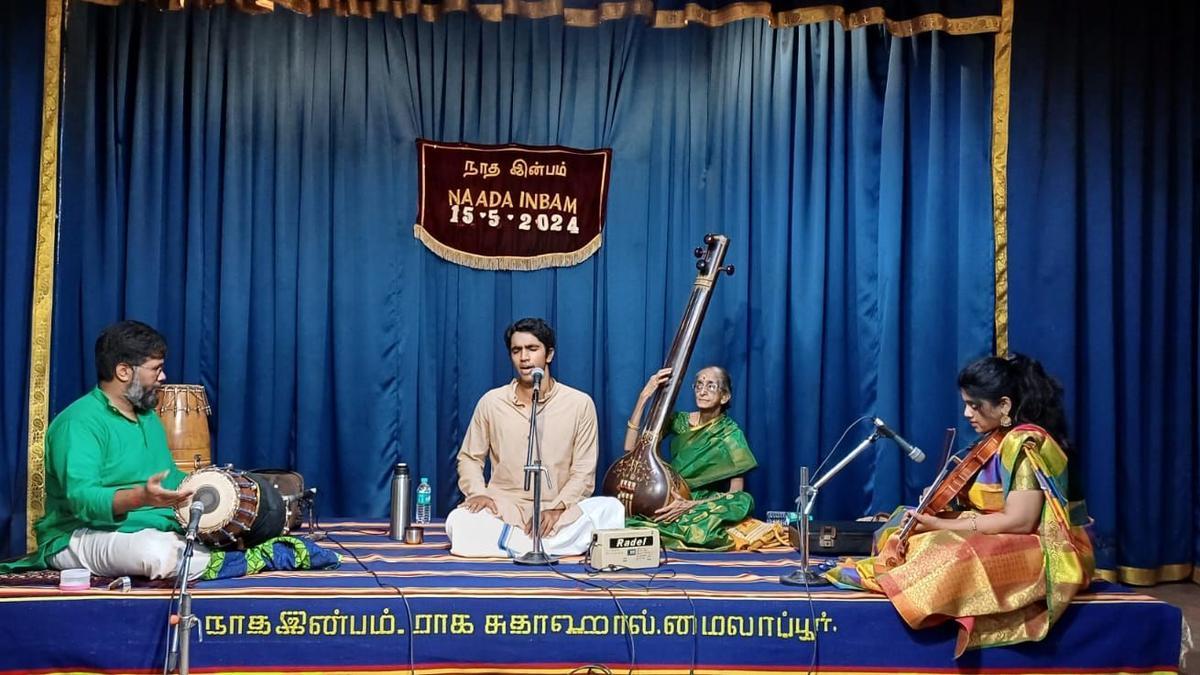
Naada Inbam’s Kshetra Sankirthana Vaibhavam series embarked on a captivating musical journey through the famed temple towns of Tamil Nadu. This evocative series, featuring thematic concerts by young and talented artistes, led audiences through the historic and spiritual landscapes of Madurai, Rameswaram, and Thanjavur. The concerts were spearheaded by P. Vikram, whose renditions of kritis attributed to these revered towns brought the rich cultural legacy of these regions to life.
Madurai, with its imposing Sri Meenakshi Sundareswarar Temple, was the first stop on this musical sojourn. Dominating the city’s skyline, the temple’s influence permeates the very fabric of Madurai’s daily life, with much of the city’s commerce and festivities revolving around it. The temple’s grandeur is celebrated during various festivals, including the Thirukalyanam (celestial wedding) during the Chithirai Brahmotsavam in April-May, the Navarathri festival in September-October, and the Masi Mandala Utsavam in February-March.
Dedicated to Meenakshi and Sundareswarar, the temple is richly chronicled in Sangam literature. The sprawling complex, spread over 14 acres, features 14 colorful gopurams (gateway towers), a thousand-pillared hall, a hundred-pillared hall, the Portramarai kulam (golden lotus pond), and the Kambatthadi mandapam, which is particularly renowned for its intricate depictions of the 25 forms of Shiva.
Vikram’s concert in Madurai featured six out of the nine songs dedicated to the town. The highlight was Syama Sastri’s ‘Sarojadala netri’ on Meenakshi, where Vikram’s alapana in Sankarabharanam, a complete raga, perfectly encapsulated the grandeur and melodious allure of this sarva gamaka rakti raga. Vikram, trained by his father and noted vainika-gayaka, S.P. Ramh, showcased his versatile vocal prowess, managing tristhayi with ease, and his inventive raga elucidation combined with expressive delivery captivated the audience.
The niraval and swaraprastara at ‘Samagana vinodini’ were particularly noteworthy. On violin, Shraddha Ravindran, a disciple of the violin virtuoso A. Kanyakumari, matched Vikram’s prowess with her responses in the alapana, niraval, and kalpanaswara segments. Mridangam artist Akshay Ram added rhythmic profundity to the concert, with his expansive and aesthetically satisfying thani, particularly elaborating on the Khanda nadai with a serene and reposeful gait.
Vikram commenced his performance with Lalgudi Jayaraman’s impressive Navarasa varnam ‘Angayarkkanni,’ a ragamalika varnam featuring Bilahari, Husseni, Valachi, Saranga, Sucharitra, Atana, Rasikapriya, Sahana, and Nadanamakriya.
. Syama Sastri’s Anandabhairavi kriti, coupled with an expressive alapana and swaras at the pallavi, was beautifully rendered. Another memorable rendition was Lalgudi Jayaraman’s composition ‘Thenmadurai vaazh annaiye’ in Hamsarupini, a lilting chittaswara janyam of Harikamboji. Vikram also rendered Swami Dayananda Saraswathi’s ‘Madhura madhura Meenakshi’ in Bageshri, preceded by a ragamalika virutham. The Tiruppugazh in Tilang, ‘Ni thatthuvamaaki,’ celebrated Muruga of Madurai.
Next on the journey was Thanjavur, home to the magnificent Brihadeeswara Temple, also known as Peruvudaiyar Kovil. Built around 1010 AD by King Rajaraja Chola I, this temple is one of India’s largest. Its main tower rises 216 feet, making it the tallest of its kind globally, and houses a gigantic Lingam and Nandi statue. The entire temple structure is carved from stone, adding to its awe-inspiring presence.
In Thanjavur, Vikram performed two pieces, including Dikshithar’s ‘Paranthama yuvathi jayathi’ (Rupakam) set in raga Dharmavati, and ‘Ulagellaam thozhavanthu,’ a Thevaram verse in Manirangu by Karuvur Thevar dedicated to Rajarajeswarar. Both compositions were met with appreciation from the audience.
The final destination was the Ramanathaswamy Temple at Rameswaram, a site imbued with the legend of Lord Rama. According to belief, Rama worshipped Shiva here after defeating Ravana to seek atonement. The temple, renowned for its 22 teerthams (sacred water bodies), is a major pilgrimage site.
At Rameswaram, Vikram delivered an extensive alapana in Pantuvarali, followed by Dikshitar’s ‘Ramanatham bhajeham’ (Rupakam). The niraval and swaras at ‘Kumara guruguha viditham’ further exemplified Vikram’s exceptional control and musical insight. Once again, Shraddha Ravindran and Akshay Ram’s accompaniments enhanced the concert, with Shraddha’s responses to Dharmavati and Anandabhairavi’s alapanas proving exemplary.
Thematic concerts such as these demand diligent research and careful planning to authentically represent the spiritual and cultural ethos of the regions they depict. Through his adept musicality and thoughtful curation, Vikram presented a series that was both enlightening and deeply engaging. This initiative by Naada Inbam not only showcased young talent but also celebrated the profound connection between Carnatic music and the historic temple towns of Tamil Nadu.












